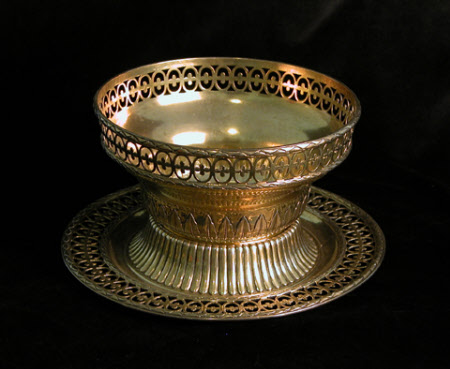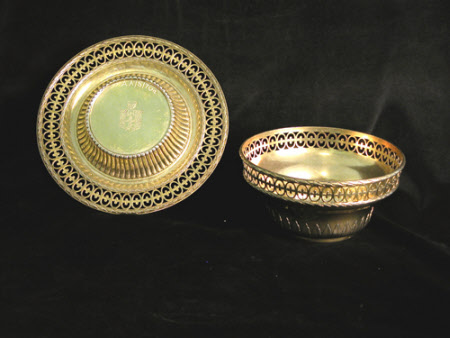Pair of fruit bowls on stands
Daniel Henry Pontifex (1768-1826)
Date
1796 - 1797
Materials
Silver-gilt, sterling
Measurements
Both: 11.2 x 22.6 cm; No.1: 890 g; No.2: 895 g (weight)
Place of origin
London
Order this imageCollection
Anglesey Abbey, Cambridgeshire
NT 516461
Summary
A pair of fruit bowls on stands, silver-gilt (sterling), mark of Daniel Pontifex, London, 1796/7. Each circular ogee-shaped bowl and its circular stand are raised and pierced with a border of ovolos encircling quatrefoils between two applied borders of overlapping laurel leaves. Round each bowl’s flat base is a wide embossed border of stiff leaves. The stands have a dished well before rising with embossed fluted sides to a flat platform. Each bowl is engraved on one side with a coat of arms and on the opposite side with a crest. The same armorials are engraved in the centre of each stand. Heraldry: The arms and crest are those of COCKERELL quartering JACKSON, PEPYS, TALBOT and another, for Samuel Pepys Cockerell (1754-1827), with WHETHAM in pretence for his wife Anne, who he married in 1782. Hallmarks: Fully marked on the base of each bowl and stand: ‘DP’ (Daniel Pontifex*), lion passant (sterling), ‘A’ (1796/7), leopard’s head (London), and monarch’s head (duty mark) *Arthur Grimwade: London Goldsmiths 1697-1837, 1990, p 46, no 494 Scratch weight: Bowl and stand 1: 28:8 Troy oz and pennyweights Bowl and stand 2: 29:15 Troy oz and pennyweights Current weight: Bowl and stand 1: 890 g or 28:3 Troy oz and pennyweights Bowl and stand 2: 895 g or 29:15 Troy oz and pennyweights
Full description
NOTES ON DANIEL PONTIFEX AND THE BOWLS’ DESIGN The family records for Daniel Pontifex state that he was apprenticed to his mother’s brother-in-law, Robert Jones. [1] As Arthur Grimwade writes that there are no records of apprenticeships for either Pontifex or Jones in the Goldsmiths’ Company’s books, it can be assumed that they both received their freedom from another of the City livery companies. [2] Pontifex is first recorded as a goldsmith when in 1791 he entered his mark as a plateworker in partnership with William Fountain. The partnership was dissolved three years later, after which Pontifex worked on his own. On 2 December 1801, he appeared at the Old Bailey in the case against Samuel Carr (or Kerr), who had been indicted for stealing five-and-a-half ounces of silver, valued at 28 shillings. Pontifex stated: ‘I am a silversmith, in St John’s Square, Clerkenwell, the prisoner was a journeyman of mine and has been so for five years next Christmas; his wages were twenty-six shillings per week. I have missed silver for near three years, and endeavoured to find out the thief.’ Carr put up no defence, but replied: ‘I have very little to say in my own defence. I have been in the habit of being an employed master myself; and was going to do a small job; I had silver of my own and only wanted to take a piece of solder, and meant to put a piece of silver in the place of it. I have served Mr Pontifex faithfully and honestly, and he has been a good master to me; but I wish I had served my God as well as I served Mr Pontifex; I should have nothing now to lament. Carr, at the age of 37, found himself transported for seven years. [3] Grimwade writes that Pontifex’s work, particularly ‘his silver-gilt dessert dishes and baskets’, shows ‘a high standard of execution and delicacy of design’. [4] This is true of Lord Fairhaven’s neo-classical bowls on stands, which are identical to a pair in the Gilbert Collection. Even the engraving of the arms appears to have been undertaken by the same craftsman. A complete service of 1794 in this pattern, comprising twenty-four plates, eight oval dishes, four kidney-shaped dishes, four cushion-shaped dishes and four circular baskets, was formerly in the collection of Earl Fitzwilliam (sold Christie’s 9 June 1948, lots 115-20).’ [5] Scratched on the base of the bowls and stands are ‘Fas S/73/1’ and ‘Fas S/7S/v’. As these marks come immediately after the scratch weights, and are in the same hand, they must be the codes for the cost of the fashioning, as silver was sold by a combination of the object’s weight and the time spent making (fashioning) it. Below the costs of the fashioning, ‘glass v/e’ is scratched. Silver fruit bowls of this design were made to hold a glass liner with a wide flared rim. The original presence of liners is confirmed by this scratched record of the cost of the glass. It’s an unusual proof that the bowls were sold with liners, which, unfortunately, Anglesey Abbey’s bowls have lost. [1] Pontifex family records: https//sites.rootsweb.com/-pjutree/3370 [2] Arthur Grimwade: London Goldsmiths 1697-1837, 1990, p 629 [3] Pontifex records: Ibid. [4] Grimwade: Ibid. [5] Timothy Schroder: The Gilbert Collection of Gold and Silver, 1988, pp 321-3 HERALDRY Samuel Pepys Cockerell (1753-1827) was the second son of John Cockerell of Bishop’s Hull, Somerset, and his wife Frances, daughter and heir of John Jackson of Clapham (who was a nephew of the diarist Samuel Pepys and the principal beneficiary of Pepys’s will). Cockerell married Anne Whetham in 1782; they had eleven children. Samuel Pepys Cockerell trained in the office of the architect Sir Robert Taylor and developed an extensive and prosperous practice. In 1774 he became Surveyor of the parish of St. George’s, Hanover Square. The following year he became clerk of works at the Tower of London, and in 1780 acquired the clerkship of Newmarket; despite his reputation for diligence and competence the re-organisation of the Office of Works led to the loss of both these posts. Upon the death of Sir Robert he succeeded him as Surveyor to the Foundling Hospital, and in 1790 presented the board of governors with a project for the development of their estate in Bloomsbury. He worked for the Admiralty, was surveyor of the Victualling Office, and from 1806 surveyor to the East India Company. As surveyor to the Bishop of London he designed much of the Paddington estate (Cockerell lived in Paddington), and he was also surveyor to the See of Canterbury. Amongst his country house commissions was Middleton Hall, Carmarthenshire, now the home of the National Botanic Gardens of Wales, and Daylesford House for Warren Hastings. Sezincote House (for his brother Sir Charles Cockerell 1st Bt., a distinguished civil servant in India), is credited with influencing the design of Brighton Pavilion, after a visit to Sezincote by the Prince Regent in 1807. Jane Ewart, 2025 Heraldry by Gale Glynn
Provenance
Samuel Pepys Cockerell David Black & Sons of 1 Burlington Gardens, London W1, sold the bowls and stands to Lord Fairhaven on 29 November 1948, for £160, Invoice 1344 (Urban) Huttleston Rogers Broughton, 1st Baron Fairhaven (1896-1966) bequeathed by Lord Fairhaven to the National Trust along with the house and the rest of the contents National Trust
Credit line
Anglesey Abbey, the Fairhaven Collection (National Trust)
Makers and roles
Daniel Henry Pontifex (1768-1826), goldsmith


